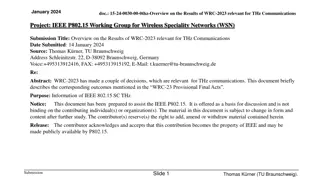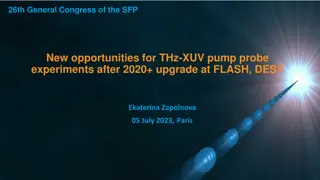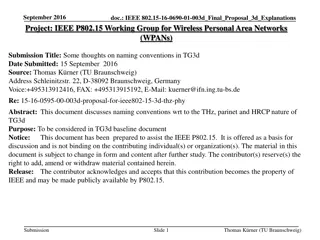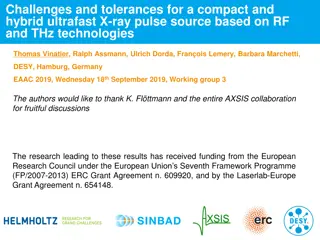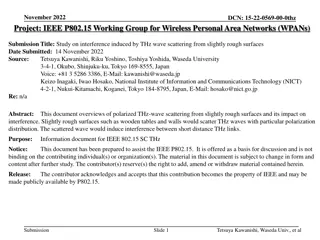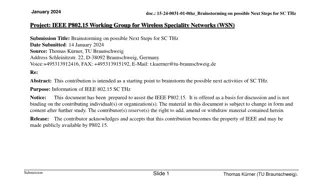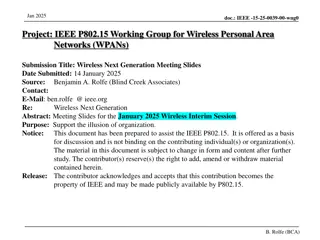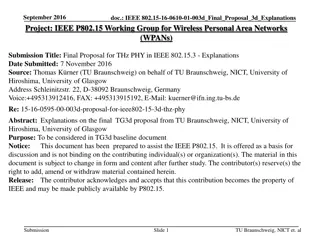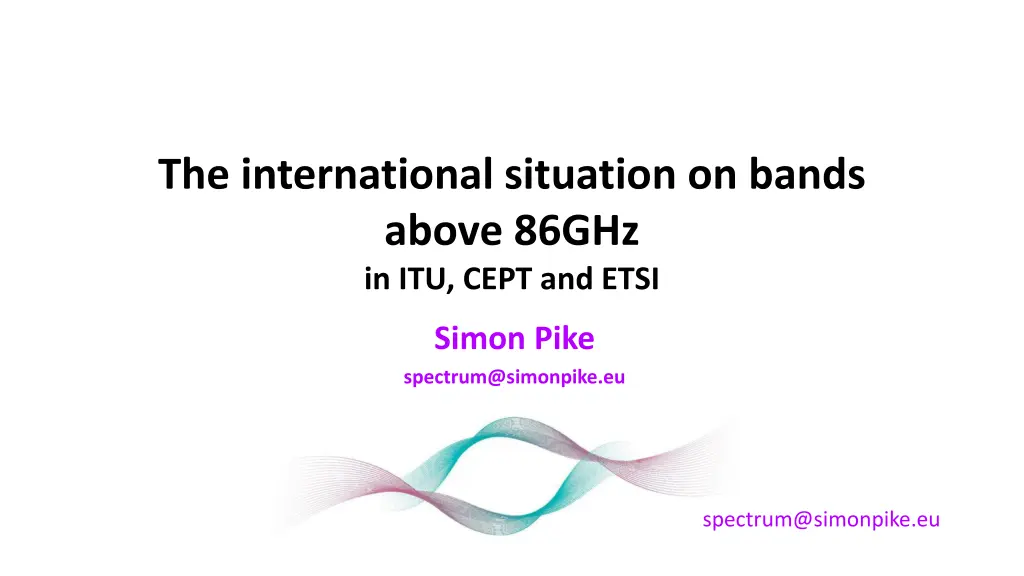
International Bands Above 86GHz: ITU, CEPT, ETSI Analysis
Explore the international spectrum situation above 86GHz, including spectrum allocations, radio astronomy considerations, and identified bands for active and passive services. Learn about the latest ITU-R studies and resolutions related to frequencies above 71GHz and their impact on emerging services and passive applications.
Download Presentation

Please find below an Image/Link to download the presentation.
The content on the website is provided AS IS for your information and personal use only. It may not be sold, licensed, or shared on other websites without obtaining consent from the author. If you encounter any issues during the download, it is possible that the publisher has removed the file from their server.
You are allowed to download the files provided on this website for personal or commercial use, subject to the condition that they are used lawfully. All files are the property of their respective owners.
The content on the website is provided AS IS for your information and personal use only. It may not be sold, licensed, or shared on other websites without obtaining consent from the author.
E N D
Presentation Transcript
The international situation on bands above 86GHz in ITU, CEPT and ETSI Simon Pike spectrum@simonpike.eu spectrum@simonpike.eu
Spectrum Allocations above 86 GHz - 21% of spectrum between 86 GHz and 275 GHz has footnote No. 5.340 - The largest contiguous band below 200 GHz with a Primary allocation for fixed and mobile is only 12.5 GHz - Only three bands have >10 GHz bandwidth - Other bands have co-primary allocations to passive services without No. 5.340 Bands available for active services between 86 and 275 GHz S5.340 Passive bands Active band Available bandwidth Fixed or mobile primary allocation Aggregate bandwidth Lower edge (GHz) 86 100 109.5 114.25 148.5 164 182 190 200 226 250 275 Upper Edge (GHz) 92 102 111.8 116 151.5 167 185 191.8 209 231.5 252 Band width Max block width 6 2 8 7.9 7.5 2.45 12.25 12.5 7.8 0 8.2 17 6 23 5.9 7.5 2.45 7.5 12.5 7.8 - 8.2 17 3.5 23 2.3 1.75 3 3 3 1.8 9 5.5 2 7.5 2.45 32.5 12.5 15 5 8.2 17 18.5 23 Simon Pike
Radio astronomy above 86 GHz There are two radio astronomy observatories in Europe operating above 86 GHz - In the French Alps (2550m ASL) and the Spanish Sierra Nevada (2850m ASL) - Both sites have significant terrain shielding The CRAF website lists more than 400 molecular resonance lines between 86 GHz and 1 THz, 47 of which are considered most important - Most are used to observe line radiation in our galaxy, so the maximum Doppler shift is low - Therefore, the bandwidth needed is also low - Co-channel sharing may be possible in some cases, because of: - the small number and remote locations of radio astronomy stations - the generally high atmospheric attenuation - transmissions at these frequencies will be highly directional - Or have extremely short range Simon Pike
Spectrum identified for active and passive services above 275GHz - Identification of spectrum within 275 450 GHz for land mobile and fixed services is addressed by No. 5.564A - For 139 GHz of this spectrum, no specific conditions are necessary to protect EESS (passive) applications - There is no mention of other active services - Identification of spectrum within 275 1000 GHz for Radio Astronomy, EESS (passive) and SRS (passive) is addressed by No. 5.565 - There are eight bands for Radio astronomy and 27 bands for EESS/SRS - Only 160 GHz bandwidth is not identified for RA or EESS/SRS - All of 275 GHz - 510 GHz is identified for RA and/or EESS/SRS - The widest band above 510 GHz not identified is 30 GHz Simon Pike
ITU-R studies on >86GHz WRC-related Resolution 731 ( for an unspecified future WRC) to accommodate the emerging requirements of active services, taking into account the requirements of the passive services, in frequency bands above 71 such as 100-102 GHz, 116-122.25 GHz, 148.5-151.5 GHz, 174.8-191.8 GHz, 226-231.5 GHz and 235-238 GHz; This would fill some of the gaps in mobile service allocations WRC-23 agenda item 1.14 to consider possible new primary frequency allocations to the Earth exploration-satellite service (passive) in the frequency range 231.5-252 GHz Preliminary agenda for WRC-27, item 2.1 to consider, in accordance with Resolution 663 (WRC-19), additional spectrum allocations to the radiolocation service on a co-primary basis in the frequency band 231.5- 275 GHz and an identification for radiolocation applications in frequency bands in the frequency range 275-700 GHz for millimetre and sub-millimetre wave imaging systems; Simon Pike
Some ongoing ITU-R studies on >86 GHz mobile and fixed Working Party 5A (Land Mobile) - Report on spectrum needs for land-mobile applications in the frequency above 275 GHz - Report on Coexistence between land-mobile and fixed service applications operating in the frequency range 252-296 GHz - Revision of Report ITU-R M.2417-0 - Technical and operational characteristics of land- mobile service applications in the frequency range 275-450 GHz Working Party 5C (Fixed Links) - Recommendations on Radio-frequency channel and block arrangements for fixed service systems operating in W Band and D Band - Recommendation on Unwanted emission levels for FS systems operating in bands from 94.1 GHz to 174.8 GHz for the protection of EESS (passive) operating in adjacent bands Working Party 5D (IMT): - Draft new Report on technical feasibility of IMT in bands above 100 GHz - due for completion in June 2023 Simon Pike
Some ongoing ITU-R studies on >86 GHz general and passive Working Party 1A (Spectrum engineering techniques) - Revision of Report ITU-R SM.2352-0 - Technology trends of active services in the frequency range 275-3 000 GHz - Revision of Report ITU-R M.2417-0 - Technical and operational characteristics of land- mobile service applications in the frequency range 275-450 GHz - New Recommendation on Complementing current radio frequency delivery mechanisms using Optical wireless communication Working Party 7C (Remote sensing systems) - Sharing and compatibility studies related to the protection of EESS (passive) above 71 GHz Working Party 7D (Radio astronomy): - New Report on Technical and operational characteristics of widely distributed-array mm-wave and sub-mm-wave systems above 200 GHz - New Report on Sharing above 71 GHz in response to Resolution 731 Simon Pike
Some ITU-R deliverables on >86GHz Recommendation F.2004: Radio-frequency channel arrangements for fixed service systems operating in the 92-95 GHz range Report RA.1860: Preferred frequency bands for radio astronomical measurements in the range 1-3 THz Report M.2500: Coexistence between high-speed railway radiocommunication system between train and trackside operating in the frequency bands 92-94 GHz, 94.1-100 GHz and 102-109.5 GHz, and radio astronomy service and Earth exploration-satellite service (EESS) (active) and EESS Simon Pike
CEPT Recommendations and Reports CEPT Report 77 - Technical harmonisation of radio spectrum for use by short range devices - Includes 122-122,25 GHz, 122,25-123 GHz and 244-246 GHz ECC Recommendation ECC/REC/(14)01 (updated in 2018) - Radio frequency channel arrangements for fixed service systems operating in the band 92-95 GHz ECC Recommendation ECC/REC/(18)01 (2018) - Radio frequency channel/block arrangements for Fixed Service systems operating in the bands 130-134 GHz, 141-148.5 GHz, 151.5-164 GHz and 167-174.8 GHz ECC Report 334 (2022) - UWB radiodetermination applications in the frequency range 116-260 GHz ECC Report 282 (2018) - Point-to-Point Radio Links in the Frequency Ranges 92-114.25 GHz and 130-174.8 GHz ECC Report 190 (2013) - Compatibility between Short-Range Devices (SRD) and EESS (passive) in the 122 to 122.25 GHz band Simon Pike
CEPT Work items SE24_75 - Additional UWB radiodetermination applications within the frequency range 116 GHz to 260 GHz for vehicular use - To carry out studies in the candidate bands 116 to 130 GHz, 134 to 141 GHz and 141 to 148,5 GHz , limited to the consideration of the two following applications SRD/MG_51 - To consider the ETSI system reference document on UWB radiodetermination applications in the range 116 GHz to 260 GHz - After completion of studies and/or investigations, this may lead to new entries in ERC/REC 70-03 and/or revised or new ECC Decision Simon Pike
ETSI Work items ISG millimeter Wave Transmission (ISG mWT) - Analysis of Spectrum, License Schemes and Network Scenarios in the RF bands above 174,8 GHz - Analysis of Spectrum, License Schemes and Network Scenarios in the W-band - Analysis of Spectrum, License Schemes and Network Scenarios in the D-band ERM TGUWB - Technical Report: Material Characterization and Shielding Attenuation Models above 100 GHz - (many TGUWB deliverables are applicable above 86GHz) ATTM TM4 - Characteristics and requirements for W and D-band PP equipment and antennas - PP Antenna Preliminary study on RPE (radiation pattern envelope) for 92-114.25 GHz and 130-174.8 GHz bands Simon Pike
Extra information Canadian Consultation on the Technical and Policy Framework for the Frequency Bands Above 95 GHz: https://www.ic.gc.ca/eic/site/smt-gst.nsf/eng/sf11767.html Closing date for comments: April 29, 2022 Closing date for reply comments: June 3, 2022 Information on sensing and TeraHertz technologies: Industrial Applications of Terahertz Sensing: State of Play https://mdpi-res.com/d_attachment/sensors/sensors-19-04203/article_deploy/sensors- 19-04203-v2.pdf?version=1570689041 Realizing the untapped potentials of the terahertz spectrum: The IET Harvey Lecture https://tv.theiet.org/?videoid=15351 Simon Pike
ITU-R Resolution 663 resolves to invite the ITU Radiocommunication Sector 1 to study the future requirements for globally harmonized spectrum for the RLS, in particular for millimetre and sub-millimetre wave imaging applications above 231.5 GHz, as referred to in considering a) and b) ; 2 to define technical and operational characteristics, including required protection criteria, for millimetre and sub- millimetre wave imaging systems; 3 to study sharing and compatibility of active millimetre and sub-millimetre wave imaging applications with other systems in the frequency range between 231.5 GHz and 275 GHz, while ensuring that the EESS (passive), SRS (passive) and RAS allocated in this frequency range are protected; 4 to conduct sharing and compatibility studies between RLS applications and EESS (passive), SRS (passive) and RAS applications operating in the frequency range 275-700 GHz, while maintaining protection of the passive service applications identified in No. 5.565; 5 to study sharing and compatibility of receive-only millimetre and sub-millimetre wave imaging with other systems in the frequency range between 275 GHz and 700 GHz; 6 to study possible new allocations to the RLS on a co-primary basis in the frequency range between 231.5 GHz and 275 GHz, while ensuring the protection of existing services in the frequency bands considered and, as appropriate, adjacent frequency bands; 7 to study a possible identification of frequency bands in the frequency range 275-700 GHz for use by RLS applications; 8 to review studies under 1 to 7, and elaborate regulatory measures for the possible introduction of millimetre and sub-millimetre wave imaging systems; applications Simon Pike
ITU-R Resolution 731 resolves to invite a future competent world radiocommunication conference to consider the results of ITU-R studies referred to in invites the ITU Radiocommunication Sector below with a view to taking the necessary action, as appropriate, in order to accommodate the emerging requirements of active services, taking into account the requirements of the passive services, in frequency bands above 71 GHz, invites the ITU Radiocommunication Sector 1 to continue its studies to determine if and under what conditions sharing is possible between active and passive services in the frequency bands above 71 GHz, such as, but not limited to, 100-102 GHz, 116-122.25 GHz, 148.5-151.5 GHz, 174.8-191.8 GHz, 226-231.5 GHz and 235-238 GHz; 2 to conduct studies to determine the specific conditions to be applied to the land-mobile and fixed-service applications to ensure the protection of EESS (passive) applications in the frequency bands 296-306 GHz, 313- 318 GHz and 333-356 GHz; 3 to study means of avoiding adjacent-band interference from space services (downlinks) into radio astronomy frequency bands above 71 GHz; 4 to take into account the principles of burden-sharing to the extent practicable in their studies; 5 to complete the necessary studies when the technical characteristics of the active services in these frequency bands are known; 6 to develop Recommendations specifying sharing criteria for those frequency bands where sharing is feasible, Simon Pike


